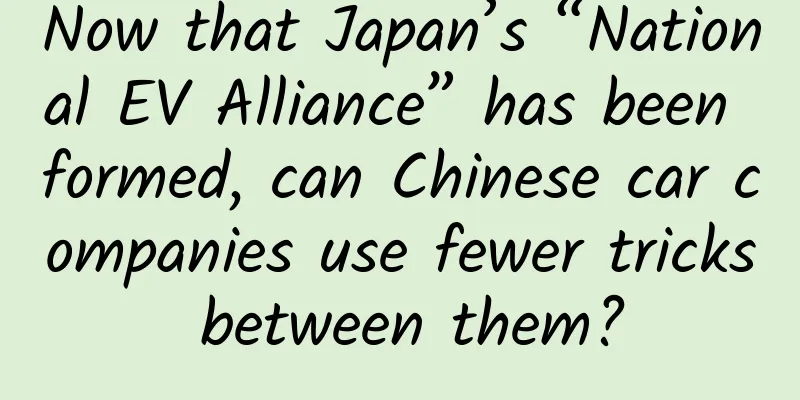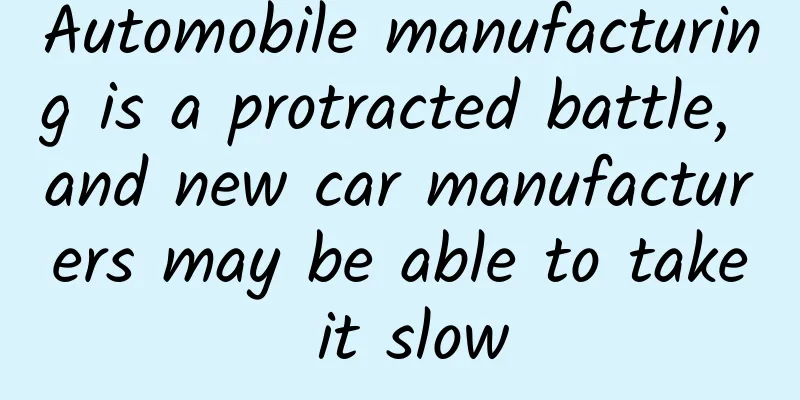Now that Japan’s “National EV Alliance” has been formed, can Chinese car companies use fewer tricks between them?

|
If you want to know what best reflects the confidence of domestic brands, it is the four words "not inferior to joint ventures". Indeed, some domestic brands have also produced some popular products that are not inferior to joint ventures in sales, such as Geely Boyue, Haval H6 and GAC Trumpchi GS8. But is there still a gap between domestic brands and joint venture brands? Of course there is. Looking at the global market, the scale of domestic brands is still far behind that of automobile powers such as Europe, the United States and Japan. What is the gap between Chinese automakers and joint venture brands? Some people say it is in the accumulation of experience in car manufacturing, but in 91che's opinion, the biggest gap is the cohesion between Chinese automakers, which is precisely the advantage of foreign automakers. Other people's group warmth On August 4, 2017, Toyota and Mazda signed a cooperation agreement, and the two parties jointly invested to establish the National EV Alliance (EV.Common Architecture Spirit.Co.) to lead the research and development of electric vehicle technology and share new research and development technologies, thereby reducing costs and accelerating the research and development process. A few months later, at the end of 2017, four Japanese auto giants, Suzuki, Daihatsu, Subaru and Hino, announced that they would join the company led by Toyota, contribute their own technology, jointly bear R&D expenses, and share technological achievements, but not own shares of the technology company. This also marks that the national EV alliance led by Toyota has formed a basic pattern. In fact, it is not new for Japanese automakers to stick together. In 2005, when Toyota Motor Corporation's newly appointed president, Katsuaki Watanabe, talked about Toyota Motor Corporation's acquisition of Subaru, he said: "We have an obligation to help our competitors, especially when they are in trouble." Also at the end of April 2016, Mitsubishi Motors, like Volkswagen, fell into the "fuel consumption scandal". However, less than a week after the Mitsubishi "fuel consumption scandal" was exposed, Nissan Motors spent 237 billion yen (about 1.84 billion US dollars) to acquire more than 30% of Mitsubishi Motors' shares, forming the Renault-Nissan-Mitsubishi Alliance, which is now among the top three in global sales. In Europe and the United States, cooperation between car companies is also common. Not long ago, the media revealed that German auto giants such as Volkswagen, Mercedes-Benz and BMW began to form an alliance in the 1990s. Mercedes-Benz and BMW, who seemed to be fighting each other, had actually reached a tacit understanding long ago: you focus on luxury and comfortable riding, and I focus on driving experience. Many car test drive editors have always had a question when doing comparisons between Mercedes-Benz and BMW in the same class: Mercedes-Benz has never made significant improvements in driving control, and BMW has never made a qualitative leap in the refinement of its interior. Did they agree on this? Yes, they did! They are giving each other a break. In addition, Fiat and GM, Mercedes-Benz and Infiniti have collaborated on production platforms, and PSA and BMW have also jointly developed small turbocharged engines. They all know how to unite, which is also an important factor in why European and American countries and Japan have achieved global leadership in the automotive industry. Auto giants that are more powerful than Chinese automakers actually understand the importance of unity better than we do. Shouldn't domestic brands reflect on this? Backstabbing among Chinese automakers There is a saying in China: People are afraid of being famous, and pigs are afraid of being fat. This saying is also very suitable for the Chinese automobile industry. BYD executives complained: Once there is negative news about BYD on the Internet, some large state-owned enterprises hire water armies to repost it with great enthusiasm! Geely executives complained: Whenever Geely releases a new car, there will be a large number of car critics on the Internet, and dirty water will overflow. Even Geely and BYD were like this. Great Wall Motors, which hardly put out any advertisements that year, was naturally criticized even more. The relevant person in charge of Great Wall Motors expressed these negative events more directly: Now the gun hits the bird that sticks out, and whoever does well will be smeared. Some brands even specially hired a group of professional car haters to attack other brands, which has become a feature of the industry. Judging from a sales guide manual leaked from SAIC dealers in 2016, what these executives said is also reasonable and well-founded. Nowadays, China's independent brands are fighting on their own. Those with advanced technology are unwilling to share, fearing that they will be surpassed by others and lose their status in the future. Those with backward technology are unwilling to invest, and they close the door to concentrate on positive research and development, preferring to starve to death rather than compromise with others. Why is it difficult for independent brands to expand their scale now? The key factor is here! What's wrong with banding together for warmth? Do they feel that they have lost face or have too much resentment between each other and have become irreconcilable? Or is there some hidden secret? No matter what, China's local independent brands are all brothers in the same camp. No matter what we say, we must unite as one, be more sincere and less routine. It has always been said that independent brands have taken the lead in the new energy vehicle market, and this is also a good opportunity for them to "overtake on the curve". However, in this new energy vehicle market with an annual sales volume of only 700,000, hundreds of participants have squeezed into it. If they continue to fight alone, when the new energy subsidies are cancelled in 2020, how much power will they have to fight back against the collective attack of global auto giants? In short, there is not much time left for independent brands! As a winner of Toutiao's Qingyun Plan and Baijiahao's Bai+ Plan, the 2019 Baidu Digital Author of the Year, the Baijiahao's Most Popular Author in the Technology Field, the 2019 Sogou Technology and Culture Author, and the 2021 Baijiahao Quarterly Influential Creator, he has won many awards, including the 2013 Sohu Best Industry Media Person, the 2015 China New Media Entrepreneurship Competition Beijing Third Place, the 2015 Guangmang Experience Award, the 2015 China New Media Entrepreneurship Competition Finals Third Place, and the 2018 Baidu Dynamic Annual Powerful Celebrity. |
>>: Geely's first 7-seat mid-size SUV spy photos
Recommend
What amazing buildings were there in the city of Shaoxing, the capital of the Yue Kingdom? Unveiling the mystery of the capital of the Yue Kingdom!
Not long ago, the State Administration of Cultura...
Optimization of Sogou promotion account and writing of excellent creative ideas
A good idea is one that netizens are willing to v...
Comparing the pros and cons of Android and iPhone
[[171222]] When we compare Android vs. iPhone, it...
Relying on LTE, Qualcomm has become the invisible "God" in the field of smartphones
In the mobile phone industry, Qualcomm is as omni...
iOS8 hidden feature: Unicom version of iPhone 5 uses Telecom 3G
Apple released iOS8 Beta1 in the early morning of ...
Apple officially releases OS X Yosemite 10.10.1, improves Wi-Fi reliability
[[122861]] Apple today officially released OS X Y...
It is said that a Chinese poet thousands of years ago "saw" the Earth from outer space...
The Mengtian Laboratory Cabin has recently become...
Apple maintains the integrity of its mobile phones
I believe that users who care about the developmen...
The most comprehensive guide to placing Toutiao search ads!
ByteDance has been continuously developing its se...
Community operation: the key point to keep the community active!
I ate and drank too much in the first half of the...
Pinduoduo Marketing Promotion Methods in 2022
As Pinduoduo grows in size, there is a saying tha...
The CTO behind a technical team of 1,000 people: CTO training is far more than technical training
[51CTO.com original article] While most technical...
15 key activity designs in the social network operations of 5 major brands
When it comes to community operations , many peop...
vivo S6 mobile phone review: a four-camera phone with super long standby time in the 5G era
Although the dividends of the current smartphone ...
Policies promote the acceleration of integration of the auto parts industry, and the future scale may exceed 4 trillion yuan
Recently, with the reduction of tariffs on import...









